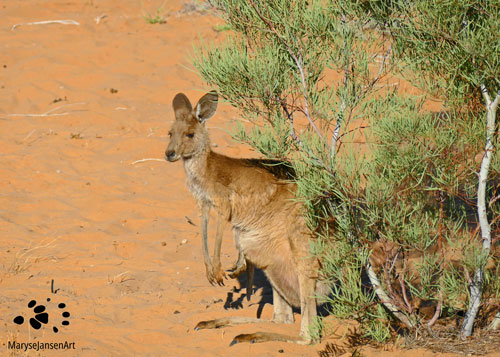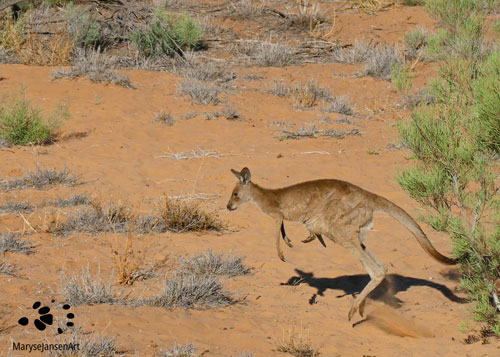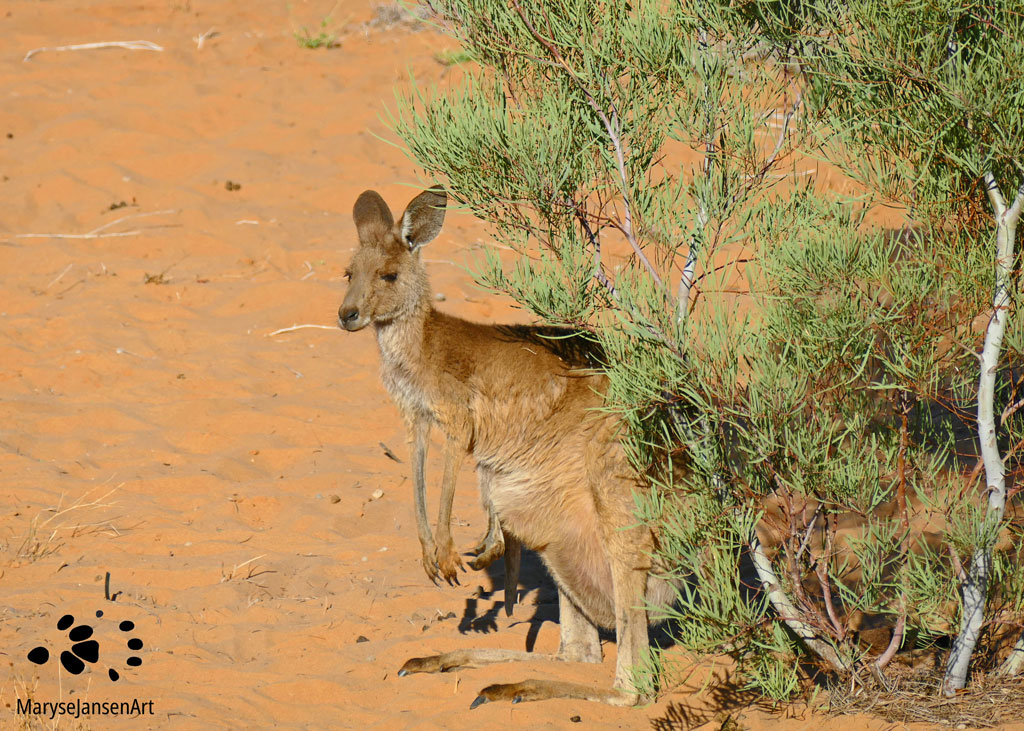Wildlife Photography with marysejansenart
She has a joey in her pouch!

Would you agree that the kangaroo is possibly Australia’s biggest icon? Not only is it a well-known symbol of Australia all over the world, the kangaroo also appears on the Australian coat-of-arms together with the emu! Did you know that both the emu and the kangaroo are animals that are not able to move backwards and that they were chosen on the coat-of-arms because this characteristic symbolizes progress for the nation.
Table of Contents
Big Foot
A kangaroo is a ‘macropod’, which literally means ‘big foot’, referring to a family of animals that are marsupials and have short fore limbs and large hind limbs used for leaping. Other animals in the family of Macropodidae are wallabies, wallaroos, pademelons, tree-kangaroos and quokkas. There are 3 species of kangaroo. The most well-known is probably the Red Kangaroo, but this is not the one most people will encounter as it lives in the semi-arid and arid interior of Australia.
The Western Grey Kangaroo and the Eastern Grey Kangaroo are sighted much more often. They look quite similar but live in different areas of Australia (although there is some overlap). In this post I’ll talk about the Eastern Grey Kangaroo which lives in a large area covering the eastern third of Australia. They are a common sight in bush-land, open grassland, woodlands, coastal areas, sub-tropical forests and even in semi-arid areas which is where they overlap with the Western Grey Kangaroo and the Red Kangaroo.
Kangaroos in zoos and in the wild
I have had many encounters with kangaroos. In zoos and wildlife sanctuaries in Australia it is quite common that you can pet and feed them (only with the specialized food provided by the zoo or sanctuary!) which of course is a super fun experience for young and old and certainly for those from overseas! But to me there’s nothing like seeing an animal in the wild, in their natural surroundings!
Eastern Grey Kangaroos are very common. Despite that they’ve been pushed further out as their habitat here in the urban areas of south-east Queensland is thinning. But where there’s space and nature, there are kangaroos! So whenever I go to the outback, I know I will see a lot of them. They are mostly nocturnal, so driving around during the day I mostly find them hanging out in the shade of a tree. Early morning or late afternoon they’re more active, grazing and hopping around.
Once it gets dark you have to be very careful when driving out on the road. The expression ‘like a deer in the headlights’ is very applicable to our kangaroos, who sadly often end up in a fatal collision with oncoming traffic. Personally I prefer to avoid driving in the dark on roads where it’s likely that I might encounter a kangaroo, and if I really have to I will adjust my speed and keep a close eye on the road side.
Outback Kangaroo
Back to daylight now. During a trip through semi-arid south-west Queensland I’m going for a walk. It is early in the morning which is a good time of the day to do this because even in winter the sun gets hot really quickly out here! I am enjoying the landscape: the orange colours of the dirt dotted with green shrubs. There are a couple of kangaroos about. Eastern Greys live in mobs of about 10. There are males and females in these mobs but only the most dominant male will get to mate with the females in the group.
I see a few of them hopping shyly away from me. Behind a nearby shrub I spot a female peeking around the little bush and there is clear evidence that she has a joey in her pouch. I can see 2 paws and a piece of tail sticking out! What a great photo opportunity: an iconic animal, in an iconic outback setting, and with a young in her pouch!
The fact that the limbs are sticking out of the pouch like that indicates that the joey is getting big. It won’t be long before it will leave the pouch permanently. At the current stage it is probably venturing out on small adventures, staying close to mum!
The wonders of the breeding cycle of a kangaroo
The breeding cycle of these kangaroos is very interesting! Only 36 days after mating a tiny joey is born, no bigger then a lima bean. It’s hairless and blind, completely helpless. However, somehow it finds it’s way into mummy’s pouch without help and attaches to one of her teats. It will continue to develop for a couple of months there. When it has developed fur and grown strong enough, which takes about 4 months, it will leave the pouch for the first time.
Gradually, it will spend more and more time outside of the pouch but it will keep coming back for milk and protection. After about 12 months it will leave the pouch for good, but it will still stay close to mum for a while for protection.
The moment the newborn joey reaches the pouch the female will mate and get pregnant again. But, as long as she carries her joey, she is able to pause the development of her pregnancy! This is called ‘embryonic diapause’. It is a very clever system, because if she loses her first joey, she’s able to quickly give birth to the next one. If the first joey does well, she just waits with the next one until the older joey begins leaving her pouch.
She keeps producing milk for the first joey while it’s exploring the outside world and it comes back occasionally into the pouch for a drink. The second joey is born and attaches to another teat. Both teats produce a different type of milk at once! The older joey benefits form high carbohydrate milk as it’s being active and the younger one receives milk high in fat to help it grow. And during all of that, a third embryo is waiting for the right time to be born! Isn’t that amazing?!
Ready, set, go
Eastern Grey Kangaroos are the second largest marsupial in the world. Males can have a body length of 1.3m and a tail length of 1m, they can weigh up to 66kg. Females are a bit smaller. A top-speed of 65 km/h has been measured!
A few moments after I take the first photo, this beautiful creature decides it is time to go. She hops away with great leaps, another good photo-moment!

If you are interested in purchasing ‘Outback Kangaroo’ or would like to see what it looks like on the various products, please head to my shop.
For more interesting facts about kangaroos, click here!


